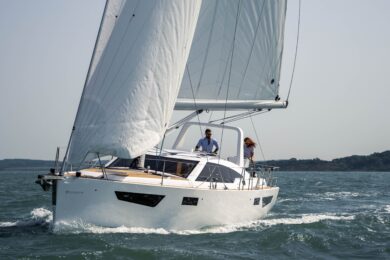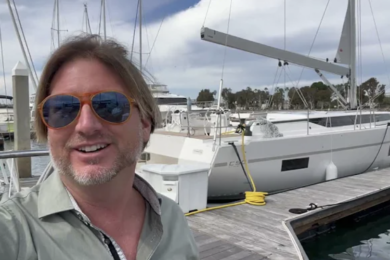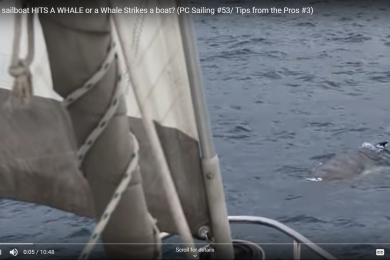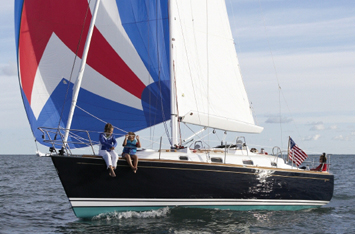 TARTAN 3400 • The new Tartan 3400 combines high-tech construction and modern design with classic Tartan styling
TARTAN 3400 • The new Tartan 3400 combines high-tech construction and modern design with classic Tartan styling
The name Tartan has become synonymous with enduring cruising boats that combine satisfying sailing performance with top construction and comfortable, well thought out accommodations. In the company’s portfolio of boats that have become classics are the great Tartan 27, the Tartan 30, Tartan 33, Tartan 34, Tartan 37 and Tartan 40. And that is not to mention the current fleet of boats (3500, 3800, 4100 and 4400) that are all classics in the making.
Of all the boats from Tartan’s past, the original Tartan 34 has to stand out as a boat for the ages since it was in constant production for more than two decades and evolved through continuous improvement and refinement during that time. Nearly 1,000 34s are out there and remain the standard in well built mid-range family cruising boats.
It must have caused Tartan’s chief designer and CEO Tim Jackett some trepidation when he decided it was time to renew the 34 brand with a completely new design. The question had to be, could the new 3400 ever really replace the venerable 34?
The simple answer is yes. The new 3400 is a design and manufacturing effort that did not look to the past for inspiration but takes all of the best qualities embodied in the Tartan brand – classic styling, fine sailing performance and sensible accommodations – and filters them through a vision that is focused firmly on the future. And that, BWS believes, will be the secret to the new boat’s enduring success.
BWS had the opportunity to spend a day aboard a new 3400 and sailed extensively on Rhode Island’s Narragansett Bay. The weather was fine and the breeze pleasantly light so we did not have the chance to see how the boat performs in rough weather and bumpy seas. What we did find, however, was that the new 3400 is a rare pleasure to sail, easy to handle and as complete a package as you will find in a cruising boat of this size.
DESIGN AND CONSTRUCTION
The brief for the new 3400 was to create a boat that more than lives up to the Tartan name by providing her owners with a small cruiser that sails extremely well, makes few physical demands on the crew and makes the most of Tartan’s cutting edge boatbuilding technology.
The hull Jackett created for the 3400 has a 30-foot waterline and almost 12 feet of beam which translates into a boat that has a lot of interior volume for it size. The bow sections have been given a slight V-shape to prevent slamming when sailing to windward in a chop while the stern sections carry the beam well aft which enhances reaching and running power and overall boat speed.
The rudder is positioned well aft where it will have the most leverage and has been designed to be a moderate balanced spade that grips the water even when heeled over and provides the helmsman with a very sure, almost sports car feel on the wheel.
The boat has three keel options to suit a wide range of sailing and cruising conditions. The standard deep fin, drawing six and a half feet, will maximize performance. For those who frequent sailing grounds with a lot of shallows – Southern New England, the Chesapeake, Florida’s West Coast, the Bahamas, etc. – Tartan offers two shoal draft options.
The Tartan Beavertail keel draws just under five feet; a fin with a large ballasted tail (that looks like a beaver’s tail), the keel reduces draft while providing the efficiencies of a bulb keel that has a positive “endplate” effect.
For those in really shoal areas, Tartan offers the tried-and-true keel/centerboard option that draws just under four feet with the board up and seven feet with the board down. Tartan has been building keel/ centerboard cruisers for 40 years and has the technology mastered.
The interesting thing about the various keel options is that the keels are interchangeable. Move the boat from the Chesapeake to the Pacific Northwest and you can swap out the keel/centerboard for the deep fin. This versatility will appeal to sailors who have to move their cruising bases and will be a real boon for boats on the brokerage market later on.
The rig on the new 3400 combines sailing power with some very innovative thinking about sail handling and control. Both the main and boom are carbon fiber (Awlgripped white) and set up with a simple two-spreader rig. The full-battened main is large and powerful; the mainsheet runs from mid-boom and the cabintop traveler forward to the mast and then back to the cockpit.
An innovative “pocket boom,” which is V-shaped, makes lowering the big sail – with the aid of lazy jacks – extremely simple since the sail flakes itself in the boom and then can be covered with the in-boom sail cover. Before making the mooring or dropping the anchor, all you have to do is round up into the wind, let go the halyard and presto the main is down and under complete control.
The headsail system is equally innovative. The working 100- percent jib has been set up on a Harken roller-furling unit and a Harken track to be self-tacking. The sheet runs from the jib’s traveler up the front of the mast and then down to the deck and aft to the cockpit. To short tack the boat through a crowded harbor all you have to do is throw over the wheel, let the main and jib tack themselves and off you go on the new tack – no winch grinding required.
For reaching and downwind sailing, a reacher, also on a Harken roller, has been set up forward of the working jib. When it is time to fall off the wind all you have to do is roll up the jib, roll out the reacher and away you go with tons of horsepower flying in front of you. This system, called a Solent Rig in Europe, makes a lot of sense as it greatly simplifies sail handling while offering the right sails for every angle of wind. Tartan is unique among production builders (along with J/ Boats) for equipping their boats with carbon masts and booms as standard equipment. The decision to do so underscores the company’s efforts to lead the way with the best modern technology can offer. The weight savings in the mast translates into a stiffer boat that is less likely to roll or pitch in short seas. It also will be easier to tune and maintain than an aluminum spar.
The 3400’s non-dimensional numbers tell more about its design philosophy and performance capabilities. With a ballast-todisplacement ratio of 0.34, the boat will be stiff and stable but not a grouch in rolling conditions. The displacement-to-length ratio of 171.3 is in the performance range – light but not too light – indicating that the hull is light and easily driven. Lastly, the sail areato- displacement ratio of 18.8 places the boat in the performance end of the cruising spectrum, but indicates that the 3400 will be able to carry full sail up to about 20 knots apparent.
To achieve both the lightness in the hull and deck that enhances boat speed and to create a boat that is as strong and durable as possible, Tartan has adopted a standard building technique that it usually employed only in high-end custom yachts and one-off racing machines.
The hull laminates are a composite of unidirectional eglass, epoxy resin and Corecell coring that are laid up as a single unit and then infused with the epoxy to create a hull that has the highest glass-to-resin ratio possible – 65-percent glass to 35- percent resin. The finished hulls are then cured in an autoclave oven at 145 degrees for 24 hours to ensure that the epoxy has fully cured.
The resulting hulls are lighter, stronger and more durable than a standard polyester resin hull, which is why Tartan can offer a 15-year transferable warranty against delamination and blisters. The weight that has been saved in the hull can be moved into the keel to enhance stability and sailing performance.
The deck is formed in a similar process, although Baltec AL600 balsawood coring, which is stiffer than Corecell, is used to make the decks as stiff underfoot as possible.
An innovative design concept combined with cutting edge construction techniques makes the new 3400 (and the other current Tartan models) a performance cruiser that will last a long, long time and will require very little structural maintenance along the way.
ACCOMMODATIONS
One of the decisions Jackett and the Tartan team had to make when they set out to design the new 3400 was how to meet the needs of their likely customers. They came down on the side of the new boat as a “couple’s cruiser” that would be a comfortable coastal cruiser (with occasional offshore runs) and a fine daysailer with a boatload of friends.
The emphasis, therefore, was on making the interior as spacious as possible while providing the owners with a large double berth in the quarter cabin and a large head, with a separate shower stall.
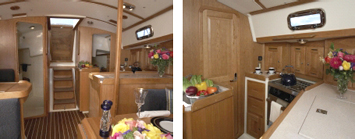 The guest cabin forward has a V-berth that is small by most standards, due in part to the fineness of the bow. The V-berth is a true double berth but two tall people will find themselves locking toes in the night, which might be a good thing. The forward cabin has a lot of storage and hanging space.
The guest cabin forward has a V-berth that is small by most standards, due in part to the fineness of the bow. The V-berth is a true double berth but two tall people will find themselves locking toes in the night, which might be a good thing. The forward cabin has a lot of storage and hanging space.
The main cabin makes use of the boat’s ample beam by pushing the settee benches outboard as far as possible. The drop leaf table runs down the centerline and with the leaves in place will accommodate four adults for a meal.
The galley has a two-burner Force 10 stove, a large sink and an ample icebox. Counters are Granicote (like Corian), which is easy to clean and maintain. A microwave oven and refrigeration are available options.
Navigators will like working at the chart table. The seat is comfortable and the table’s surface is wide enough for a standard chart kit. Electronics can be flush mounted above the chart table. The main electric panels are above the chart table and to starboard.
Like most modern Tartans, polished cherry has been used through the boat for joinery and cabinets. Drawer fronts, doors and doorframes are solid wood, so they feel substantial and open and close with a satisfying thud. Door hardware and all latches are polished chrome and top-ofthe- line so you do not have to worry about a door, drawer or cabinet door flying open in a bouncy seaway.
Out of the box the 3400 is not set up as a passagemaker, but the boat is certainly capable of carrying her crew – most likely a couple – far and wide with the addition of tankage for extra fuel and water, an upgraded battery bank and charging system and all the sundry safety and navigational gear cruising boats require.
SAIL TRIALS
Our day aboard the 3400 turned out to be clear and pleasant with a sea breeze blowing up Narragansett Bay. We picked up the boat in Bristol Harbor, not far from the Herreshoff museum, and motored through the mooring field to open water. The boat responded easily and quickly under power and did not display much prop-walk as we backed and filled around the slips on departure. The saildrive unit is behind the keel so the propwash does not adversely affect the rudder.
The 27-horsepower Yanmar diesel pushes the boat well. At mid-revs (around 1,800 rpms) we chugged through flat water at six knots. At full revs (around 2,800 rpms) we got her up to seven and half knots or slightly above theoretical hull speed.
Engine noise in the cockpit was minimal, but we did not measure decibels at various rpms. Down below, the engine noise was slightly more pronounced, but we could talk at normal voice levels and did not find the engine a distraction. The insulation inside the engine box appears to be working well.
Hoisting the mainsail on the Harken Battcar system was easy, and we soon had the boat slipping along under main alone at five knots. The big main drives the boat well so close maneuvering under mainsail alone will be the best way to get through tight situations.
We rolled out the 100-percent jib, trimmed for close-haul sailing and headed down the bay at six knots with about 12 knots apparent wind flowing over the deck. Not bad.
Putting the 3400 through her paces, we tacked back and forth, spinning the 40-inch wheel and letting the self-tacking jib do all the work. The boat carried her way through the tacks nicely and then stood up to the new tack quickly. Like most fin-keelers, it helps to fall off a bit after a tack to gain speed before inching the bow up to close hauled.
After about an hour of playing with the set and trim of the sails up wind, we rolled in the jib, fell off to a beam reach and rolled out the reacher. Compared to the jib, the reacher appeared huge; immediately upon filling, the 3400 took off as though hooked to a team of horses.
We broad reached along for a while, watching the speedo move from six to well over seven knots. All the while the helm was incredibly balanced and light. The hull’s broad transom and full sections aft left a smooth wake behind us as the water rushing past the hull met little form resistance. The large rudder, on the rack-and-pinion steering system, truly provided fingertip steering and the ability to make minute and accurate course corrections.
The reacher on a Solent Rig such as this can be a bear to jibe since the space between the two roller-furling systems is small. The trick is to head the boat dead downwind, blanket the reacher behind the mainsail, haul on the new leeward sheet until the clew passes through the gap and then jibe the boat as you haul in the reacher’s sheet. This sounds difficult but once you get the hang of it, nothing could be easier. An autopilot helps a lot if you are doing this solo.
Tim Jackett set out to build a boat that is fun and easy to sail and BWS can confirm that the new 3400 fulfills these goals as well as any boat we have sailed recently.
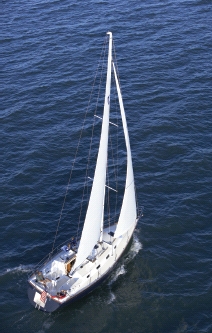 BWS THOUGHTS
BWS THOUGHTS
When Tartan introduced the first 34 to their line in the 1960s, a boat of this size was considered a normal or even large cruising boat. Many, in those days, happily went cruising in boats under 30 and survived quite well.
By today’s standards, the 3400 is a small cruiser and most modern sailors would consider it too small for extended sailing. The trend has been to ever larger boats with ever more numerous and complex systems designed to bring the comforts of home to sea with us. And part of that equation is that larger cruising boats can be difficult for couples of a certain age to sail.
Larger boats are all well and good. But there is a lot to say for simplicity and for going to sea in a boat that is easy to sail. Not only will you sail more if it is easy to do so, you will have more fun in the process.
The new 3400 is just the kind of boat veteran sailors will enjoy for weekending, coastal cruising, the occasional offshore passage and for daysailing with friends and family. And for more adventurous souls, the 3400 is packing all the quality, all the strength and all the seakindliness to carry her crew to the Caribbean, Mexico and beyond.
Can the new 3400 live up to the legendary status of the old 34? We are betting it can and may in time well surpass the old classic.
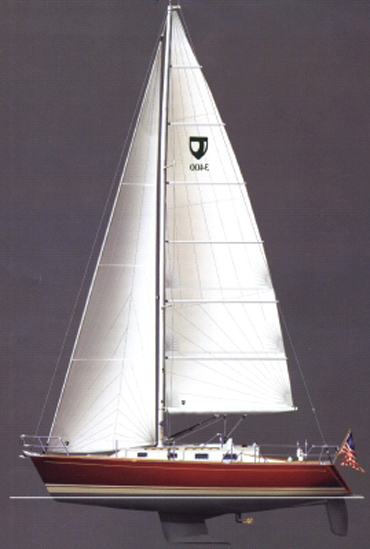
TARTAN 3400
LOA 34’5″
LWL 30’5″
Beam 11’11”
Deep 6’6″
Shoal 4’11”
Centerboard 3’11″/7’0″
Displacement 11,000 lbs.
Ballast 3,700 lbs.
Sail Area (100%) 620 sq. ft.
Water 60 gals.
Fuel 25 gals.
Air draft 55′
SA/D 18.8
D/L 171.3
B/D 0.34
Base Price $157,395
Tartan Yachts
1920 Fairport Nusrsery Rd.
Fairport Harbor, OH 44077
Ph: 440-357-7777
www.tartanyachts.com

